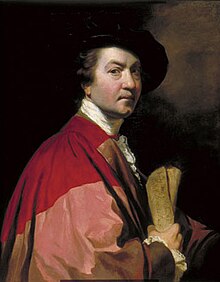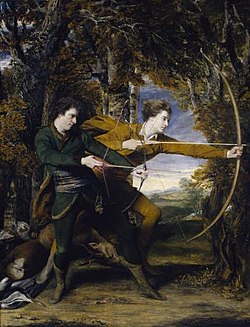Joshua Reynolds




Sir Joshua Reynolds RA FRS FRSA (July 16, 1723 – February 23, 1792) was the most important and influential of 18th century English painters, specialising in portraits and promoting the "Grand Style" in painting which depended on idealization of the imperfect. He was one of the founders and first President of the Royal Academy. George III appreciated his merits and knighted him in 1769.
Biography
Reynolds was born in Plympton, Devon, on 16 July 1723. As one of eleven children, and the son of the village school-master, his formal education was restricted to what his father taught him. Despite this, Reynolds exhibeted a natural curiosity, and as a boy came under the influence of Zachariah Mudge, whose Platonistic philosophy stayed with him all his life.
Showing an early interest in Art, Reynolds apprenticed in 1740 to the fashionable portrait painter Thomas Hudson, with whom he remained until 1743. From 1749 to 1752, he spent over two years in Italy, where he studied the Old Masters and acquired a taste for the "Grand Style". Unfortunately, whilst in Rome, Reynolds suffered severe cold which leaft him partially deafened, and as a result he began to carry a small ear trumpet with which he is often pictured. From 1753 until the rest of his life he lived London, his talents gaining recognition soon after his arrival.
Reynolds worked long hours in his studio, rarely taking a vacation. Despite this he was both gregarious and keenly intellectual, with a great number of friends from London's intelligentsia, numbered amongst which were Dr Samuel Johnson, Oliver Goldsmith, Edmund Burke, Henry Thrale, David Garrick and fellow artist Angelica Kauffmann. Because of his popularity as a portrait painter, Reynolds enjoyed constant interaction with the wealthy and famous men and women of the day, and it was he who first brought together the famous figures of "The" Club.
With his rival Thomas Gainsborough, Reynolds was the dominant English portraitist of 'the Age of Johnson'. It is said that in his long life he painted as many as three thousand portraits. In 1789 he lost the sight of his left eye, which finally forced him into retirement, and on 23 February 1792 he died in his house in Leicester Fields, London. He was buried in St. Paul's Cathedral.
Status and Reputation
Professionally, Reynolds' career never peaked. He was one of the earliest members of the Royal Society of Arts, and with Gainsborough established the Royal Academy of Arts as a spin-off organisation. In 1856 he was made the RA's first President, a position he held until his death. As a lecturer, Reynolds' Discourses on Art (delivered between 1769 and 1790) are remembered for their sensitivity and perception. In one of these lectures he was of the opinion that "invention, strictly speaking, is little more than a new combination of those images which have been previously gathered and deposited in the memory."
Reynolds and the Royal Academy have historically received a mixed reception. Critics include many of the Pre-Raphaelites, and William Blake, the latter having published his vitriolic Annotations to Sir Joshua Reynolds' Discourses in 1808. To the contrary, both J. M. W. Turner and James Northcote were fervent acolytes: Turner requested he be lain to rest at Reynolds' side, and Northcote (who lived for four years as Reynolds' pupil) wrote to his family "I know him thoroughly, and all his faults, I am sure, and yet almost worship him." The word worship is second cast; originally Northcote had written adore.
Character sketch
In appearance Reynolds was not in any way striking. Slight of frame, he was just about 5'6" with dark brown curls, a florid complexion and features which James Boswell thought were "rather too largely and strongly limned." He had a broad face, a cleft chin, and the bridge of his nose was notably dented; his skin was scarred by smallpox, and his upper lip disfigured as a result of falling from a horse as a young man. Nonetheless he was not considered ugly, and Edmond Malone asserted that "his appearance at first sight impressed the spectator with the idea of a well-born and well-bred English gentleman."
Renown for his placidity, Reynolds often claimed that he "hated nobody". Never quite losing his Devonshire accent, he was not only an amiable and original conversationalist but a friendly and generous host, so that Fanny Burney recorded in her diary that he had "a suavity of disposition that set everybody at their ease in his society", and William Makepeace Thackeray believed "of all the polite men of that age, Joshua Reynolds was the finest gentleman." Dr. Johnson commented on the inoffensiveness of his nature; Edmund Burke noted his "strong turn for humor". Thomas Bernard, who later became Bishop of Killaloe, wrote in his verses on Reynolds:
"Dear knight of Plympton, teach me how
To suffer, with unruffled brow
And smile serene, like thine,
The jest uncouth or truth severe;
To such I'll turn my deafest ear
And calmly drink my wine.
Thou say'st not only skill is gained
But genius too may be attained
By studious imitation;
Thy temper mild, thy genius fine
I'll copy till I make them mine
By constant application."
Admitedly, some did construe Reynolds' equable calm as cool and unfeeling. Hester Lynch Piozzi's pen-portrait reads:
"Of Reynolds what good shall be said?- or what harm?
His temper too frigid; his pencil too warm;
A rage for sublimity ill understood,
To seek still for the great, by forsaking the good..."
Indeed, it is to this luke-warm temperament that Frederick W. Hilles, Bodman Professor of English Literature at Yale attributes the fact Reynolds never married. In the editorial notes of his compendium Portraits by Sir Joshua Reynolds, Hilles theorizes that "as a corollary one might say that he [Reynolds] was somewhat lacking in a capacity for love", and cites Boswell's notary papers: "He said the reason he would never marry was that every woman whom he liked had grown indifferent to him, and he had been glad he did not marry her." Reynolds' own sister, Frances, who lived with him as housekeeper, took her own negative opinion further still, thinking him "a gloomy tyrant". Strangely, it was this very presence of family that compensated Reynolds for the absence of a wife; He wrote on one occasion to his friend Bennet Langton, that both his sister and niece were away from home "so that I am quite a bachelor." Biographer Ian McIntyre discusses the possibility of Reynolds having enjoyed sexual rendezvous with certain cliants, such as Nelly O'Brien (or "My Lady O'Brien", as he playfully dubbed her) and Kitty Fisher, who visited his house for more sittings than were strictly necessary. Claims to this end are, however, purely speculative.
See also
External links
Books
- The Letters of Sir Joshua Reynolds
- Seven Discourses on Art at Project Gutenberg
- Sir Joshua Reynolds, A Complete Catalogue of His Paintings, by David Mannings and Martin Postle
- Sir Joshua Reynolds: The Painter in Society
- Works by Joshua Reynolds at Project Gutenberg
- National Portrait Gallery Collection
- Reynolds portraits from the Lady Lever Art Gallery collection
- National Gallery of Art, Washington, D.C.: Sir Joshua Reynolds
- Sir Joshua Reynolds (1723–1792)
- Sir Joshua Reynolds (1723–92)
- Artcyclopedia: Sir Joshua Reynolds
- Sir Joshua Reynolds at Olga's Gallery
- Twelve Joshua Reynolds portraits in Henry Thrale's library.
- Sir Joshua Reynolds, by a 1900 biography by Estelle M. Hurll, from Project Gutenberg
